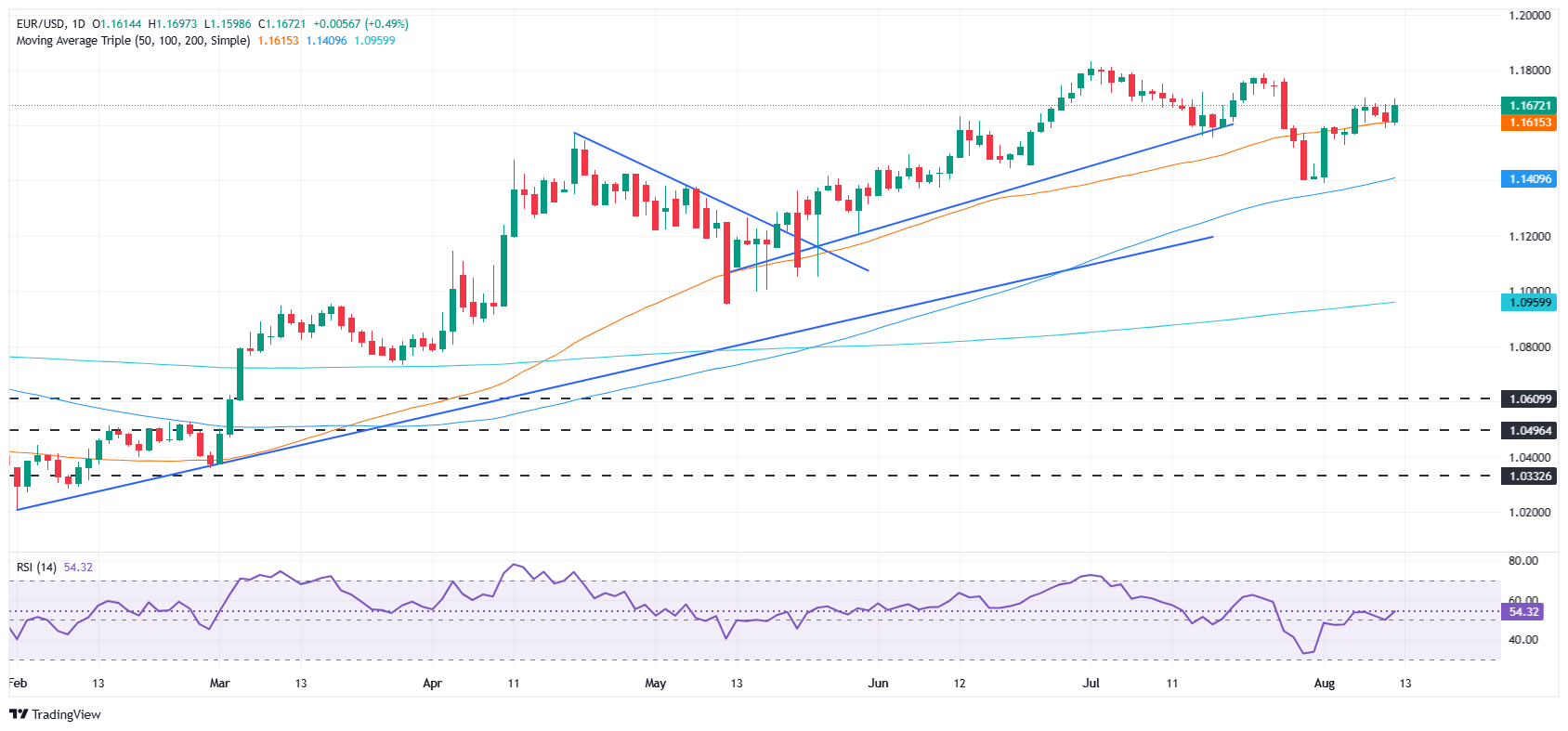
- EUR/USD is up 0.50% to 1.1673 after July US CPI shows a flat headline but a hotter core print.
- Markets still price in >90% chance of a September Fed rate cut despite core CPI beat.
- Trump slams Powell for being “too late” on cuts, threatens lawsuit over Fed building renovations.
The EUR/USD rises during the North American session, following the release of mixed inflation figures in the United States (US) and US President Donald Trump’s threats to sue the Fed Chair Jerome Powell. At the time of writing, the pair edges up 0.50% at 1.1673.
Market mood remains positive with US stocks boosted by mixed readings on the Consumer Price Index (CPI). Although headline inflation was unchanged, underlying numbers exceeded estimates, though it was ignored by market participants, who had priced in over 90% chances of a rate cut by the Federal Reserve.
Following the figures, Trump slammed the Fed Chair Jerome Powell for being “TOO LATE” to cut rates and threatened to pursue a lawsuit against him, over the Fed building renovations.
In the meantime, a slew of Federal Reserve officials crossed the wires, led by the Kansas City Fed President Jeffrey Schmid, who was hawkish. The Richmond Fed President Thomas Barkin adopted a more neutral stance.
At the same time as Barkin crossed the wires, on CNBC, the Fed board Trump nominee Dr. Stephen Miran crossed the wires, and said that the Fed’s independence is paramount, though he didn’t speak further, as the Senate has not approved him.
Across the pond, the latest European Union (EU) ZEW Survey of Expectations for August plunged from 36.1 to 25.1. The figures in Germany deteriorated sharply in August due to the disappointing trade agreement reached with the United States and the declining economic output in Q2. Germany’s ZEW Economic Sentiment fell from 52.7 to 34.7 in August, below forecasts of 39.8.
The US and EU economic docket will be busy on Wednesday. In the US, the Fed parade will continue as Fed Regional Presidents Thomas Barkin, Austan Goolsbee, and Raphael Bostic will cross the wires. The EU schedule will feature German and Spanish CPI on Wednesday.
Euro PRICE This week
The table below shows the percentage change of Euro (EUR) against listed major currencies this week. Euro was the strongest against the Japanese Yen.
| USD | EUR | GBP | JPY | CAD | AUD | NZD | CHF | |
|---|---|---|---|---|---|---|---|---|
| USD | -0.22% | -0.37% | 0.19% | 0.14% | -0.05% | 0.10% | -0.27% | |
| EUR | 0.22% | -0.14% | 0.41% | 0.37% | 0.16% | 0.27% | -0.04% | |
| GBP | 0.37% | 0.14% | 0.50% | 0.51% | 0.31% | 0.42% | 0.10% | |
| JPY | -0.19% | -0.41% | -0.50% | -0.01% | -0.21% | -0.02% | -0.32% | |
| CAD | -0.14% | -0.37% | -0.51% | 0.00% | -0.19% | -0.09% | -0.43% | |
| AUD | 0.05% | -0.16% | -0.31% | 0.21% | 0.19% | 0.11% | -0.21% | |
| NZD | -0.10% | -0.27% | -0.42% | 0.02% | 0.09% | -0.11% | -0.32% | |
| CHF | 0.27% | 0.04% | -0.10% | 0.32% | 0.43% | 0.21% | 0.32% |
The heat map shows percentage changes of major currencies against each other. The base currency is picked from the left column, while the quote currency is picked from the top row. For example, if you pick the Euro from the left column and move along the horizontal line to the US Dollar, the percentage change displayed in the box will represent EUR (base)/USD (quote).
Daily digest market movers: EUR/USD surges as US inflation cools down
- Mixed US inflation figures failed to sway traders toward increasing bets on a Federal Reserve rate cut at the September 16–17 meeting. The Consumer Price Index (CPI) rose 2.7% YoY in July, matching June’s pace and just below the 2.8% forecast. In contrast, Core CPI accelerated to 3.1% from 2.9% the previous month, coming in slightly above expectations of 3.0%.
- Richmond Fed President Thomas Barkin said current monetary policy is well-positioned but warned the central bank will continue to face pressures on both inflation and unemployment. Kansas City Fed President Jeffrey Schmid also backed maintaining a modestly restrictive stance for now, favoring a patient approach to rate adjustments. He noted that the muted impact of tariffs on inflation suggests policy remains appropriately calibrated.
- Stephen Miran, nominated by President Trump to the Federal Reserve Board, emphasized that the central bank’s independence is “of paramount importance,” but declined to elaborate further ahead of his Senate confirmation process. He added that inflation has been “well behaved,” particularly since Trump took office.
- The US Dollar Index (DXY), which tracks the performance of the buck’s value against a basket of its peers, is down 0.44% at 98.06, a tailwind for the EUR/USD.
- The latest economic data released in the US spurred investors’ speculation that the Federal Reserve might resume its easing cycle at the upcoming September meeting. Odds for a quarter of a percentage cut are at 91%, revealed Prime Market Terminal (PMT).
- On the European Central Bank (ECB) front, the easing cycle seems to be on pause for the September meeting, with 94% odds for the ECB to keep rates unchanged, and a slim 9% chance of a 25 basis points (bps) rate cut.
Technical outlook: EUR/USD rallies towards 1.1700 after clearing 1.1650
The EUR/USD uptrend stalled even though the pair hit a weekly peak of 1.1697, just shy of the 1.1700 figure. Momentum shows that buyers are in control, as depicted by the Relative Strength Index (RSI). However, as the index turns flat, the chances of a pullback are real.
If EUR/USD edges below 1.1650, a test of the confluence of the 20 and 50-day Simple Moving Averages (SMAs) around 1.1626/19 is on the cards. Further downside is seen once those levels are cleared, with the 1.1600 mark up next.
Conversely, if EUR/USD clears 1.1700, then the next key resistance would be 1.1750, 1.1800, and the YTD high at 1.1829.

Euro FAQs
The Euro is the currency for the 19 European Union countries that belong to the Eurozone. It is the second most heavily traded currency in the world behind the US Dollar. In 2022, it accounted for 31% of all foreign exchange transactions, with an average daily turnover of over $2.2 trillion a day. EUR/USD is the most heavily traded currency pair in the world, accounting for an estimated 30% off all transactions, followed by EUR/JPY (4%), EUR/GBP (3%) and EUR/AUD (2%).
The European Central Bank (ECB) in Frankfurt, Germany, is the reserve bank for the Eurozone. The ECB sets interest rates and manages monetary policy. The ECB’s primary mandate is to maintain price stability, which means either controlling inflation or stimulating growth. Its primary tool is the raising or lowering of interest rates. Relatively high interest rates – or the expectation of higher rates – will usually benefit the Euro and vice versa. The ECB Governing Council makes monetary policy decisions at meetings held eight times a year. Decisions are made by heads of the Eurozone national banks and six permanent members, including the President of the ECB, Christine Lagarde.
Eurozone inflation data, measured by the Harmonized Index of Consumer Prices (HICP), is an important econometric for the Euro. If inflation rises more than expected, especially if above the ECB’s 2% target, it obliges the ECB to raise interest rates to bring it back under control. Relatively high interest rates compared to its counterparts will usually benefit the Euro, as it makes the region more attractive as a place for global investors to park their money.
Data releases gauge the health of the economy and can impact on the Euro. Indicators such as GDP, Manufacturing and Services PMIs, employment, and consumer sentiment surveys can all influence the direction of the single currency. A strong economy is good for the Euro. Not only does it attract more foreign investment but it may encourage the ECB to put up interest rates, which will directly strengthen the Euro. Otherwise, if economic data is weak, the Euro is likely to fall. Economic data for the four largest economies in the euro area (Germany, France, Italy and Spain) are especially significant, as they account for 75% of the Eurozone’s economy.
Another significant data release for the Euro is the Trade Balance. This indicator measures the difference between what a country earns from its exports and what it spends on imports over a given period. If a country produces highly sought after exports then its currency will gain in value purely from the extra demand created from foreign buyers seeking to purchase these goods. Therefore, a positive net Trade Balance strengthens a currency and vice versa for a negative balance.
Information on these pages contains forward-looking statements that involve risks and uncertainties. Markets and instruments profiled on this page are for informational purposes only and should not in any way come across as a recommendation to buy or sell in these assets. You should do your own thorough research before making any investment decisions. FXStreet does not in any way guarantee that this information is free from mistakes, errors, or material misstatements. It also does not guarantee that this information is of a timely nature. Investing in Open Markets involves a great deal of risk, including the loss of all or a portion of your investment, as well as emotional distress. All risks, losses and costs associated with investing, including total loss of principal, are your responsibility. The views and opinions expressed in this article are those of the authors and do not necessarily reflect the official policy or position of FXStreet nor its advertisers. The author will not be held responsible for information that is found at the end of links posted on this page.
If not otherwise explicitly mentioned in the body of the article, at the time of writing, the author has no position in any stock mentioned in this article and no business relationship with any company mentioned. The author has not received compensation for writing this article, other than from FXStreet.
FXStreet and the author do not provide personalized recommendations. The author makes no representations as to the accuracy, completeness, or suitability of this information. FXStreet and the author will not be liable for any errors, omissions or any losses, injuries or damages arising from this information and its display or use. Errors and omissions excepted.
The author and FXStreet are not registered investment advisors and nothing in this article is intended to be investment advice.








